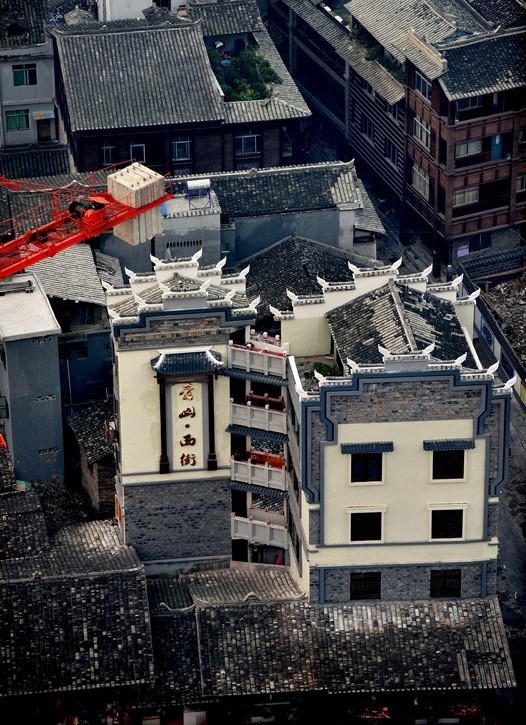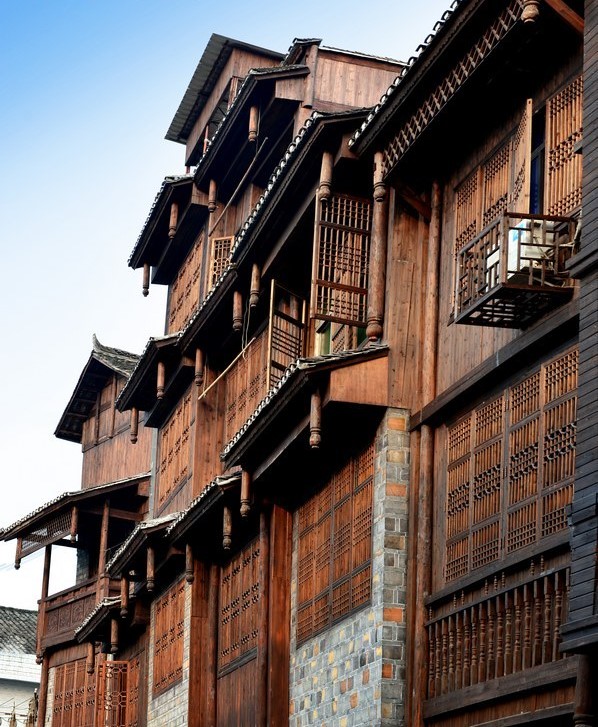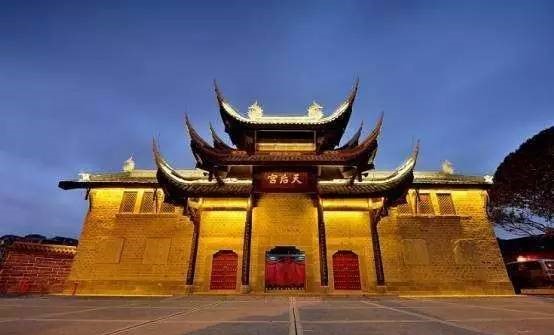Century West Street, ancient architecture exhibition hall
West Road, "a vertical and horizontal four", such as the Chengdu "wide alley," into the West Street, greeted by the slides along the streets Tujia Diaojiao and cornices Alice feet of the emblem of architecture, numerous temples It is in the market fireworks bring a trace of dust out of the mean. Today, most of the ancient meaning is inscribed on the dust, and these buildings in the long history of the river, in a quiet and leisurely manner heritage of Western culture.
Many people think that a person has a person's character, a building has the character of a building, and a street has the charm of a street, a street in the street, or even a humble shop, it is these and Different things, just let a street has a soul.
West Street intersection between the alleys is located between the countless then the Gordon House, a strip of streets and alleys are the interpretation of the history of Xiushan and today's humanities, each street has its own unique story. When you walk into the streets, touch the streets of the house with a wall, are reminding us of scenes to touch the past and present.

Diaojiaolou and Huizhou architecture, two architectural styles of the singular fusion
Into the centuries West Street, oncoming greetings is the cornices Qiaojiao white walls and black tiles, as well as the slides of a floating wooden floor. The two styles of architecture have two resounding names in architecture: the Huizhou architecture and the stilts.
Xiushan was originally a place where Tujia and Miao people lived together. Most of the residents in West Street were mostly locals, so hanging stilts became a matter of course here. Diaojiaolou as a ubiquitous living room form, all over the mountains and rivers in southeast Chongqing. Tujia emphasis on the dragon veins, Diaojiao Lou more depending on the mountain, patchwork tiger-shaped, "the left dragon, the right tiger, the former Suzaku, after basaltic" as the best housing, people live in harmony, embrace the universe of nature. Later pay attention to the direction, or sit west to east, or sit east to west. The stilt floor of West Street is exactly in accordance with this layout built.
These stilts belong to the category of dry-beam type buildings, namely "large-scale, under-the-roof space, residential housing for residential use" (Zhuang Yuguang "dry stop building"), which in the wet and humid Wuling District Moisture-proofing and ventilation are extremely beneficial and are considered by modern architects to be the best forms of ecological architecture.
Most of the stilts in the West are flat-topped, and the entire structure of the stilt floor is connected with a mortise and tenon, without a pin and without a bolt, which looks as if it is placed on the same floor. Diaojiaolou floor are made of a piece of wood mosaic. Many foreign tourists trembling on the feet, always afraid of the house will coax collapse. In fact, many dwelling houses have survived centuries-old trials and tribulations.
If we say that Diaojiaolou is the best embodiment of the local style building in the West Street, then the micro-building is the perfect combination of foreign style building and West Street. As we all know, micro-construction is a building originated in ancient Huizhou, the most obvious is the white walls and tall walls around the house, called the "envelope wall."
So, how to enter the Huizhou architecture West Street it?
This and historic Hui Merchants related. After the mid Ming Dynasty. Huizhou merchants began to rise and peaked in the Qing Dynasty. At that time, merchants in Huizhou were all over the country. Basically Huizhou merchants could be seen wherever they went. During the Qing Dynasty Tongzhi to Guangxu years, many engaged in the tung oil, private cloth, salt tea trade came to Xiushan, choose to open a business here, the bulk of the sale of goods. At that time Xiushan City, there are many well-known firms are set up by the Huizhou merchants, such as "colleagues and", "Ruitai and", "Thai and", "Insein long" and so on. These Huizhou merchants were then known as Xiushan "Jiangxi Gang", they settled here, put the Huizhou architecture also introduced Xiushan. West Street as a venue for activities at the time, naturally built a lot of Huizhou architecture.
Now walking in the West, the stilts and horsehead Qiaojiao high walls patchwork, mutual stretches, black tile white walls and logs of the air pavilion collide with each other, forming an elegant and generous color. The courtyards on both sides of the street were deep, with steps of green-colored moss and old marks on the steps. From the old time to the present. These ancient buildings are like hourglasses of time, slowly dripping long history, full of time to allow time to stay, at your fingertips.

Mysterious Temple of Heaven
Ancient theater singing opera
After the establishment of Xiushan County, the commercial development of the city started to develop. As the economy prospered, more and more foreign businessmen began to enter Xiushan. These people established a large variety of temples in Xiushan: Temple of the City, Confucian Temple, Wu Temple, Thean Hou Temple, Longevity Palace, Lord Chuanzhu, Guanyinge, Temple of Fire, Dragon King Temple, Cat Museum (Zhaowu Temple) and so on.
Among them, the most interesting should be considered the Temple of Heaven, because it is a foreign temple, worship a little and inland associated with the gods.
As we all know, the Temple of Heaven is worshiped by a god named Matsu, who is also known as Tenghu, Tin Hau and Tin Hau after the goddess, which is a common god of sailors, travelers, traders and fishermen along the southeast coast. Is the water thing. Ancient ships sailing before the sea to worship Mazu, pray for blessing the wind and safety, but also in the ship worship Matsu god worship.
So, a god of the coast, why in the southwestern inland county temple erected? This was related to the then developed trading environment. In the middle of the eighteenth century, China flourished under Emperor Qianlong's emperors and business activities throughout the country were frequent. At that time, the water transport in Fujian was well developed. In addition to the development of the ocean trade, some Hakka people in Fujian Province followed the trend of the inland water system upstream and entered the Mainland for trade. As a result, part of the people in Fujian arrived in Yuanjiang River Basin, continue upstream and upstream, into the Meijiang River, and then arrived in Xiushan City.
Later, some of these people in Fujian settled down in Xiushan. They gave birth to children and lived on behalf of generations. They formed a large-scale settlement in Xiushan. Fujian people who settled in Xiushan raised funds for the construction of the temple of Matsu and used it as a kind of spiritual support and asylum in the hometown of Fujian as a hall of funeral in Fujian. It is also a place where fellow citizens gather.
At that time, Xiushan City had a lot of people who sought life on the banks of the Meijiang River. Since they thought that Matsu was a god of water, they could bless them both in the ocean and in the inland rivers, and they would come and worship. Later, the Temple of Heaven added a stage for worship. Gradually Tin Hau Temple addition to fellow gathering place, has become a place of worship and prayer.
Fifties and sixties of last century, Xiushan Lantern Festival Song and Dance Troupe was formed, had here as a performing place, on a regular stage lantern show, very popular with the people, festivals and hurry up, come to watch the people It is simply a sea of people, called "the ancient theater left behind." Unfortunately, in a power-grid accident, the fire at the Tin Hau Temple was burned down and the place carrying the cultural heritage of Xiushan disappeared.

Today, the Temple of Heaven, the cultural landmark of West Street, has been rebuilt. In reconstruction plan, combined with the site environment, creating a dynamic visual point of view; completely restored the style of the temple, and provides a variety of display links, is a set of tea opera stage, folk culture display, cultural relics collection, business and leisure, Folk culture and other functions in one comprehensive exhibition hall.
Presumably, it will not take long before the palace will sounded the lantern opera singing.
